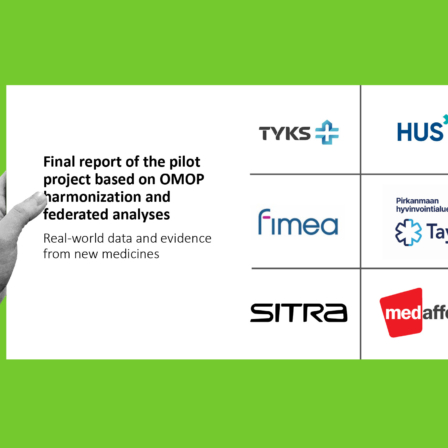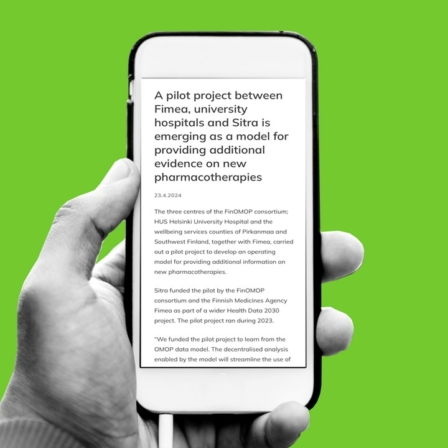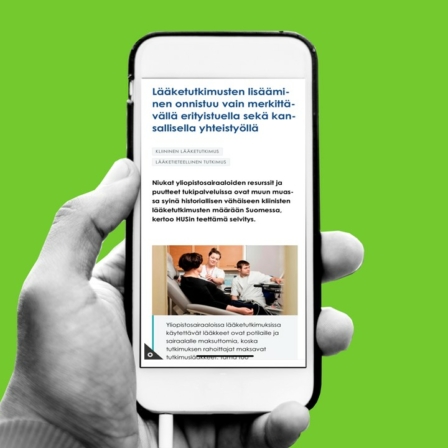Use of health data in RDI activities
Finished projects 3/2023–5/2024.
Research, development and innovation will benefit from better access to data. The projects identified the bottlenecks of the use of data and sought new solutions for using data.
What is it about?
The rapidly digitalised healthcare sector produces massive amounts of data. Its seamless use provides opportunities to develop improved services, new medicines, treatments and preventive solutions and, above all, better well-being for people.
The models and usage options for the smooth use of data are taking shape.
The projects collected experiences of the use of data and sought new practical solutions.
The projects were launched as part of the Health data 2030 project, which had already ended, and the final pilots were completed as part of the Well-being solutions project.
Results
Drug trial bottlenecks in wellbeing services counties
The project was initiated by the finding that the number of clinical drug trials of pharmaceutical companies were declining in the Hospital District of Helsinki and Uusimaa (currently HUS-yhtymä). The project assessed the reasons for this worrying trend and proposed corrective measures.
The decline in drug trials is a nationwide phenomenon and is therefore not limited to HUS. The key obstacle identified was the lack of resources in terms of doctors and nurses carrying out the trials. This is due to HUS’s internal capacity to attract researches and to the scarcity of public funding throughout the country. National approaches have not been implemented and no comprehensive, joint plans have been developed to improve the operating environment. The proposed measures are linked to addressing these shortcomings.
More information: Sitra’s article, HUS media release (8 May 2023, in Finnish) and HUS report (in Finnish)
Project party and contact person: HUS, Pirkko Lepola, pirkko.lepola (at) hus.fi
Models for monitoring the effectiveness of new medicines
The data needed for the reimbursement and introduction of new medicines is currently based on the results of clinical trials. But once introduced, treatment outcomes are not systematically monitored in the healthcare system.
The project used an operating model based on the OMOP (Observational Medical Outcomes Partnership) data model and federated analyses for monitoring the post-approval effectiveness of new medicines, using three examples. The new models will allow the outcomes of medicines and treatments to be monitored in practice without sharing individual personal data. The standardised data models will facilitate future international cooperation on the collection of additional evidence. The resulting process descriptions, models and their evaluation were published in April 2024.
The project ended on 31 December 2023. More detailed results are summarised in the report and in a concise article and Fimea news (23 April 2024).
Project implemented by: Wellbeing Services County of Pirkanmaa, Tarja Laitinen, tarja.laitinen (at) pirha.fi, Joint Authority HUS, Southwest Finland Wellbeing Services County, Fimea (Fimea news release 22 May 2023)
New methods for detecting breast cancer
Breast cancer is the most common cancer in women and a common cause of death. Progress is still needed in diagnosing the disease. New methods, including AI, can facilitate and improve the detection of breast cancer from breast cancer screening – or mammography – data.
The project developed a web-based app that allows researchers to enter mammography data and receive an analysis report based on an algorithm developed by the University of Eastern Finland. To facilitate the use of the algorithm, an interface was developed to allow the analysis model to be used to study other data. The project has also developed a platform for researchers to test their own models on the mammography data provided by the site.
In the end of 2023, the University of Eastern Finland launced also a challenge competition allowing model developers to test their own solutions on the app. The data is not accessible to the testers of the models; instead, it is handled in a secure manner separately, with the university running the models in its own secure data environment. The data is, therefore, not shared with the competition participants. The competition will run until 2024, when a scientific publication will be completed.
Project implemented by: University of Eastern Finland, Arto Mannermaa, arto.mannermaa (at) uef.fi
Streamlining the use of patient data for treatment and research
The need for and importance of everyday patient data and the research evidence derived from it have increased in health sciences research, and as part of individual patient treatment and knowledge management. The sharing and integration of real-time patient data opens up excellent opportunities for improving treatment, but currently remains a challenge. Data can only be used in research if it is complete, comprehensive and structurally expressed using standardised international concepts.
The project investigated how patient material could be better used in health care in the wellbeing services county of Southwest Finland and be included in international co-operation projects. The project developed a solution, an algorithm, to automatically import data from the wellbeing services county’s patient systems to databases in a structured format and to maintain future prescriptions as structured data.
As a spin-off of the project, was the development of a national OMOP data model (Observational Medical Outcomes Partnership), which expresses data in an internationally standardised way. This supports the accession of the wellbeing services county to the DARWIN project launched by the European Medicines Agency (EMA) as a data partner. The aim is for the wellbeing services county to be able to respond to the research requests from EMA quickly and with high quality. The OMOP data model will open up Finland’s high-quality data sources in a new way for international co-operation projects, both academic and commercial.
Project party and contact person: TYKS Turku University Hospital, Minna Blomster, minna.blomster (at) tyks.fi
Genetic information for blood donors
The aim of the project was to experiment with returning genetic information to those who have given their samples to the biobank and to understand how a supposedly healthy person experiences receiving the information. The project focused on hereditary haemochromatosis, an iron accumulation disease with a wide range of symptoms and varying severity. The most common symptoms include fatigue and joint and skin symptoms. In late stages, iron accumulation in the internal organs can cause tissue damage in areas such as the liver, pancreas and heart muscle and can lead to conditions such as diabetes.
The project developed a model for returning genetic information to samplers to prevent the development of more severe symptoms of the disease. The project eventually identified 89 donors with hereditary haemochromatosis from a pool of nearly 44 000 blood donors. Of these, 82 were sent a letter of interest to participate in the survey.
The letters sent to the donors included contact details for the designated doctors in the blood donors’ medical services, who received a total of seven calls by 30 November 2023. More extensive follow-up on blood donors’ access to health care and continuation of blood donation could not be determined during the pilot. None of the callers had previously known of their susceptibility to haemochromatosis. Callers’ questions mainly concerned the risk of offspring and other close relatives developing haemochromatosis, as well as the caller’s own recent investigations and the need for further investigations.
A key outcome of the pilot was the creation of a model for returning genetic data to sample donors at the blood donors biobank. The working group judged the model to be successful for the return of this type of data. However, for serious diseases, such as cancer, diseases of Finnish genetic heritage or other life-threatening diseases, the model developed is not suitable.
Project partner and contact person: Finnish Blood Service Biobank, Kimmo Pitkänen, kimmo.pitkanen (at) veripalvelu.fi





